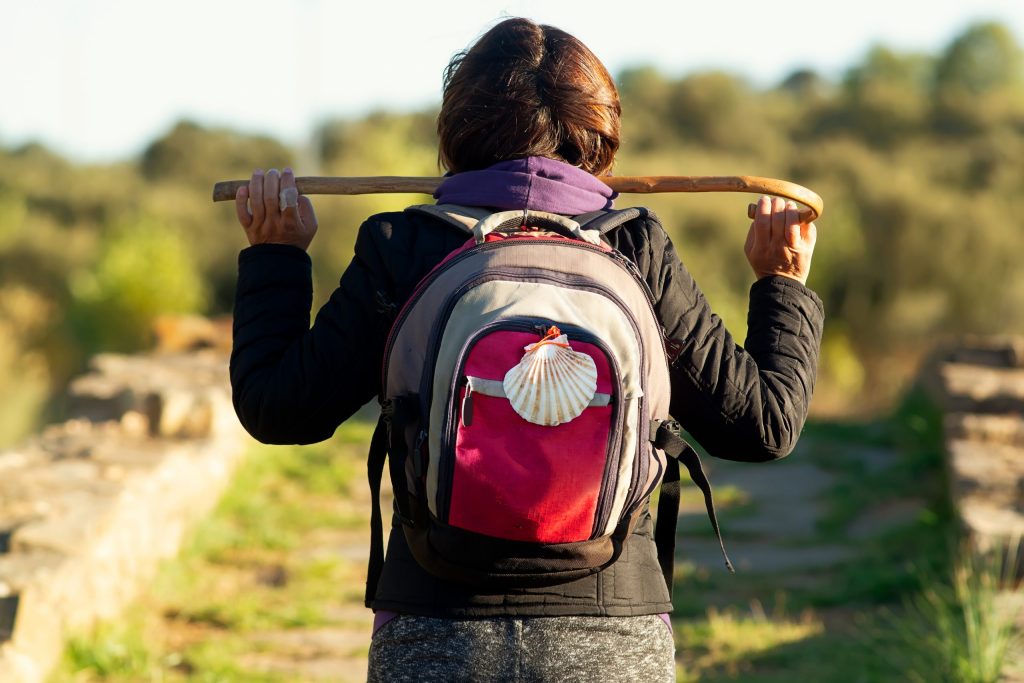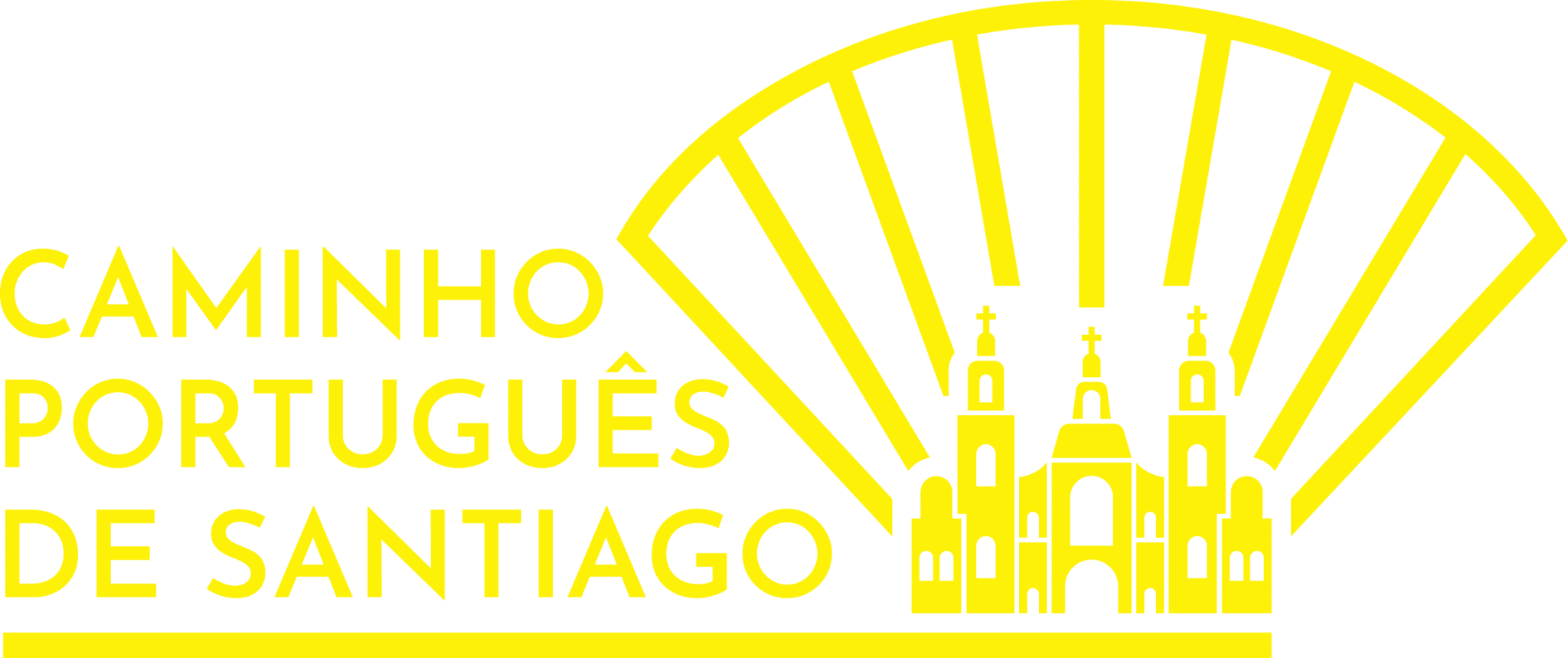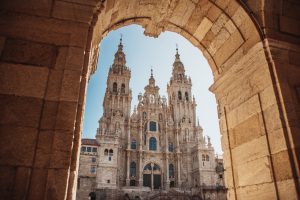Our favorite route has a millennium of history. That's why, over the years, it's normal for pilgrims to create their own rituals on their arrival in the city of Santiago de Compostela. Due to their close relationship with Catholicism, many of the rituals we're going to mention in this article are religious. However, let's start with the arrival at the square where all the meetings take place.

Feel the emotion in the square where the route ends.
Religious or not, it is certainly one of the spiritual rituals on arrival in Santiago de Compostela that all pilgrims take part in. The Plaza del Obradoiro is the final center of the crossing named after Jesus' apostle.
People of all creeds, colors and backgrounds gather here in one big congregation to observe the goal they've just accomplished. It's time to put down your bags, take the best and worst photos possible and touch the Vieira that represents kilometer zero.
Walkers always arrive where they are expected and the Obradoiro square has been in the same place for centuries, with open arms to welcome each of these adventurers. This can be seen on every façade of the imposing buildings in every direction.
The best known is the Cathedral of Santiago de Compostela. This religious landmark was completed in the 13th century, but as the years and architectural styles have progressed, we can see in every piece of art and crevice why this building is unique.
In the first writing about the Camino, the cathedral is described as being "53 men high". An impressive height both for the time and today. It is also from here that we can see the Portico of Glory. In fact, this is part of a ritual so important that we'll talk about it and who built it later.
However, the city center of Compostela doesn't end with the religious aspect.
Just look a little to the side and you'll see the Hospital of the Catholic Kings. Don't let the name fool you, as these days it's just a reminder of its past. In the old days, when it was built, this building was actually a health facility.
Designed exclusively for pilgrims traveling to the city, it was built in the 16th century by Isabella of Castile and Ferdinand II of Aragon, who were known by the name of the hospital: "The Catholic Kings."
However, despite its noble mission, it was converted into a luxury hotel in 1950. But what is born good will always have a vocation, which is why it still welcomes pilgrims from all over the world. This year, offered againWe will provide 3 meals a day for the first 10 pilgrims to Compostela. All you have to do is go to the catering service and ask for the pilgrim's room. However, if you want to keep your certificate as a souvenir, you shouldn't use this service, as the "payment" is that document.
If you want to know more about the Compostela, we'll talk about it in the last point! Stay tuned!
Designed exclusively for the pilgrims who came to the city, it was built in the 16th century by Isabella of Castile and Ferdinand II of Aragon, who were known by the name of the hospital.
So the emotion that is felt in this place is contagious in all spheres of public life. Take a deep breath when you're here and, when the time is right, you can make your way to the Plaza de Quintana.
However, if you feel nostalgic, the region of Galicia has a webcam that is on 24 hours a day, always aimed at the Plaza del Obradoiro from different angles. Follow this link to try it out.
Let's see if the Holy Door is open.
(Until December 31, 2022, don't let this opportunity pass you by!)
You'd expect all the gates in Santiago de Compostela to have an aura of holiness. However, it is in the Quintana square, also known for the Legend of the Phantom Pilgrim, that we find the one of the city where the walk ends.
Although they exist all over the planet, especially in countries with a strong Catholic component, this one is special. Find out below!
The year the cathedral was completed, in 1122, Pope Calixtus II declared that the next time July 25 fell on a Sunday, it would be a Jacobean year. In other words, that year, anyone who went on pilgrimage to this place would be absolved of their sins.
After just four years, it happened, starting an ancient tradition. Almost half a century later, another pope, Alexander II, understood the importance of this crossing for all believers. So he declared that the pardon would be perpetual.
However, it wasn't until four hundred years after this decision that the door was built. It has come to represent the crossing that the faithful make during the Jacobean years: their physical, emotional and spiritual side.
Spiritual rituals on arrival at the Camino de Santiago: The story of the Holy Door.
The opening of this door is also full of symbolism. Because it only opens in specific years, a tailor-made ceremony has been created for it. It all begins on December 31, before the Jacobean year.
Since it is locked from the inside, making it impossible to open it from the outside, it is the Archbishop of Santiago de Compostela himself who has the honors of starting the celebrations of this important season.
Despite being an ancient ritual, it is still followed by thousands of people today. It consists of knocking three times on a stone structure, placed days before, which is glued to the door. When it falls, the head of the town's parish washes the floor with holy water and olive branches. He is also the first to cross it.
Before the end of the year, the process is repeated, this time in reverse. Blessing a new structure that blocks the door with incense, you place it in that spot, to be opened again at an appropriate time.
For the sake of our virtues, due to the pandemic situation, Pope Francis has decreed 2022 to be a Jubilee year. So, if you haven't already done so, you can go through the Holy Door until the 31st of this year.
From here, you have direct access to the main altar and, therefore, to Santiago's tomb. In other words, you can go and perform one of the rituals on your arrival in Santiago de Compostela more quickly.
But you can also enter through the main door.
Sendo anos jacobeus ou não, a entrada pela praça das platérias está sempre aberta, das 7 às 20 da noite. Por ser a única entrada, durante grande parte do tempo, pode acontecer existirem filas longas. Contudo, podes saber, exatamente quão compridas são neste link disponibilizado pelo o website do templo.
This is more the case in summer, as there are more people. Consequently, there are more Masses. Difficulties getting in are therefore to be expected. It also doesn't help that it's forbidden to take backpacks into the eternal resting place of Jesus' Apostle.
When pilgrims find out, they tend to worry about their belongings and where to put them. The best thing to do is to take a small bag with the most important documents and your wallet.
Then you can leave the backpack on the floor, next to the wall. There is adequate security at the door and the pilgrims tend to help each other.
It is in this spirit of sharing and mutual help that one of the least talked about rituals on arrival in Santiago de Compostela was created.
While they wait, the walkers chat to each other. They tell their stories, have fun or simply listen to each other. Between photographs of the routes and last-minute selfies, the journey to the city is not the last opportunity to make friends on the Camino.
Now, before you go in, here's what you need to bear in mind: in most parts of the cathedral, access is free. However, there are some where you'll have to make a paid reservation, such as the Portico de la Gloria. Think about what you want to see and do the day before and you'll certainly be able to do it. Use this link to buy tickets.
What are the spiritual rituals on arrival in Santiago de Compostela Cathedral?
Once you've walked through the main door (or the Holy Door, if you went in the right year), you can start asking yourself what you really need to experience here. The right answer would be: everything. However, these are the most important spiritual rituals on arrival in Santiago de Compostela at this temple.
Soak up the beauty of the Main Chapel.
The largest chapel, plated in gold and with shapes that combine several architectures into one, is the culmination of the journey made by many pilgrims. You'll notice a statue at the top of the stairs and, in principle, a huge queue of people waiting to embrace it.
This is a representation of the Apostle of Jesus. One of the oldest spiritual rituals of the pilgrimage on arrival in Santiago de Compostela. It consecrates the end of the journey for many people. However, there is still so much to do.
See a pilgrim mass.
This celebration takes place every day at 12 noon. Although, as the number of pilgrims always increases, there are more of them in the summer. In the Jacobean year, there are four celebrations.
At the beginning of Mass, the faithful are greeted with a list of pilgrims who have arrived in Santiago de Compostela and gone to the pilgrim's workshop in the last 24 hours. You'll find out more about it below.
To find out when there are masses, you can visit this website, so you can plan your visit in detail.
Let yourself be impressed by the Botafumeiro.
Usually, when we imagine a Mass in the cathedral where the tomb of Jesus' apostle is located, the first image that comes to mind is of one of the most well-known spiritual rituals on arrival in Santiago de Compostela.
The Botafumeiro is an image well known to all pilgrims. They dream of seeing the giant instrument flying over the temple, while hearing the names of the people who have completed the millenary stretch.
However, it supposedly serves two ancient purposes.
First, there are always the religious rituals. Since so many people went on pilgrimage to the city named after one of the apostles, the botafumeiro works in the same way as a censer, in the hands of the priest.
This represents the attitude of the believers arriving in Santiago. Like them (and everyone reading this article), the giant censer comes closer to the Holy Spirit by simulating flight, beaconing the whole church with the intense aroma of incense and Christ.
Secondly, there's a rumor that the botafumeiro was a way of tempering the smell of the believers when they arrived at the cathedral. After so many months without bathing, it was normal for the smell to be less than pleasant on arrival. However, according to Professor Jose Carro Otero, this is just a myth.
This important figure from the world of travel mentions that the large turíbulo was, and still is, a fundamental part of the liturgy. It was even put into operation when the temple was empty. In fact, he humorously replies that odor could never have been an issue in medieval times, since hygiene conditions were not the best.
However, despite being so important, the botafumeiro has specific days to work. To find out more, follow this link.
This list includes Christmas Day, Three Kings' Day and All Saints' Day on November 1st. However, if you really want to have a mass with the botafumeiro flying between the cathedral, you'll have to send an e-mail to botafumeiro@catedraldesantiago.es and ask.
We have already done so and, when we have the answer on the conditions, we will post them here, to be available to all the people who want to take part in this rite.
So let's return to one of the most interesting rituals that has been lost over the centuries. The visit to the Portico of Glory.
After 10 years of restoration, the Pórtico de la Gloria was opened to the public once again in 2018. This 12th century architectural structure is one of the most important and renowned works of sacred art in Spain and perhaps the world.
Here, various important figures from Christianity and the stages of life and death are represented. To enter today, it is advisable to book in advance. Not only is the piece of art thousands of years old and therefore easily damaged, but there was also a tradition that didn't seem to please the priests of Compostela.
It was Mateo who designed and created the Pórtico da Glória. Or Master Mateo, as he is known from the few historical references to his life to which we have access. Apart from a life pension note from King Ferdinand II of Galicia, representations in sculptures and the lasting influence of his work on Galician art, we know little about this figure.
Even with so few reports, Master Mateo has become an icon for pilgrims from all over the world and has become part of their rituals. This is because, among all the marvelous pieces we can find in the portico, there is the Saint of Croques. According to legend, it is Mateo himself repenting for having sculpted himself next to God.
Over the centuries, pilgrims have had the habit of knocking three times, head to head, on the statue of the old master. The idea was to pass on his intelligence and wisdom to those who were walking the Way.
However, in order to prevent damage, the ritual had to be banned and even discouraged, as the sculpture was beginning to suffer from the wear and tear of time and the impact of other people's foreheads.
When you leave the cathedral, you can go to Compostela.
Let's go to one of the last spiritual rituals on arrival in Santiago de Compostela. It's time to pick up your pilgrimage certificate. Don't forget to carry your pilgrim's credential with you at all times, because you need to prove that you've walked the minimum 100 kilometers to reach Santiago de Compostela.
However, the process doesn't end there. You must first register at this link. In order for the institution to have access to the information needed to create the long-awaited document, you need to answer a few questions.
Don't worry, because you certainly know them well. We'll put them all below:
1) Mode of transport
2) Where you started
3) Mobile phone
4) E-mail.
5) First and last name.
6) Whether or not you want the distance certificate.
7) Sex
8) Age
9) Nationality
10) Reasons for pilgrimage
11) Type of profession.
You will then receive a QR code in your e-mail, which will give you access to a password when you arrive at the workshop.
However, here are some warnings about the answers:
In item 6, if you say yes, you have to pay an extra 3 euros. This is a certificate of the kilometers traveled to that point where you can even store in the surrounding stores in the city.
When people ask you why you're going on pilgrimage, you should know that Compostela is only offered to you if you walk the Christian route to the disciple's tomb.
That's what it's called in Latin:
"devotionis affectu, voti vel pietatis causa"
However, if you've walked the path for other than a spiritual or religious reason, as you have every right to do, you'll receive a Certificate.
Despite having the same name as distance, they are different. It's also free, so you can feel free when you fill in the survey. You won't be left without your proof of pilgrimage.
Have we missed any of the rituals of the Camino de Santiago?
These are the most common rituals of the ancient pilgrimage on the Iberian Peninsula. However, like all traditions, they change depending on the region, community and even the person. So, tell us, have we missed any rituals in Santiago de Compostela?











